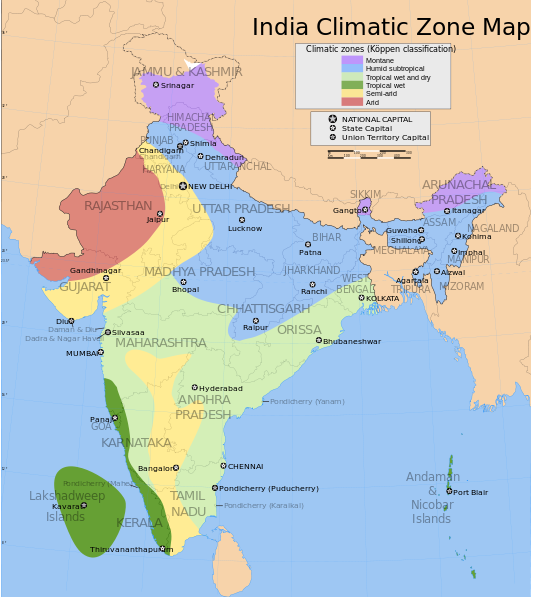India’s climate and weather
The climate of India comprises a wide range of weather conditions across a vast geographic scale and varied topography, making generalisations difficult. Based on the Köppen system, India hosts six major climatic subtypes, ranging from arid deserts in the west, alpine tundra and glaciers in the north, and humid tropical regions supporting rainforests in the southwest and the island territories. Many regions have starkly different microclimates, making it one of the most climatically diverse countries in the world. The country's meteorological department follows the international standard of four climatological seasons with some local adjustments: winter (December, January and February), summer (March, April and May), a monsoon means rainy season (June to September), and a post-monsoon period (October to November).
India's geography and geology are climatically pivotal: the Thar Desert in the northwest and the Himalayas in the north work in tandem to effect a culturally and economically important monsoonal regime. As Earth's highest and most massive mountain range, the Himalayas bar the influx of frigid katabatic winds from the icy Tibetan Plateau and northerly Central Asia. Most of North India is thus kept warm or is only mildly chilly or cold during winter; the same thermal dam keeps most regions in India hot in summer. Winter in India are too cold. It can cause fever or can make you ill.,,Though the Tropic of Cancer—the boundary between the tropics and subtropics—passes through the middle of India, the bulk of the country can be regarded as climatically tropical. As in much of the tropics, monsoonal and other weather patterns in India can be wildly unstable: epochal droughts, floods, cyclones, and other natural disasters are sporadic, but have displaced or ended millions of human lives. There is one scientific opinion which states that in South Asia such climatic events are likely to change in unpredictability, frequency, and severity. Ongoing and future vegetative changes and current sea level rises and the attendant inundation of India's low-lying coastal areas are other impacts, current or predicted, that are attributable to global warming.
Indias climate can be classified as a hot tropical country, except the northern states of Himachal Pradesh and Jammu & Kashmir in the north and Sikkim in the northeastern hills, which have a cooler, more continental influenced climate.
In most of India summer is very hot. It begins in April and continues till the beginning of October, when the monsoon rains start to fall. The heat peaks in June with temperatures in the northern plains and the west reach 45° C and more. The monsoons hit the country during this period too, beginning 1st of June when they are supposed to find the Kerala coast, moving further inland from day to day. Moisture laden trade winds sweep the country bringing heavy rains and thunderstorms; sometimes these monsoon rains can be very heavy, causing floodings and damage, especially along the big Rivers of India, Bramaputhra and Ganges.
The plains in the north and even the barren countryside of Rajasthan have a cold wave every year in December-January. Minimum temperatures could dip below 5°C but maximum temperatures usually do not fall lower than 12°C. In the northern high altitude areas of the northern mountains it snows through the winter and even summer months are only mildly warm.
Typhoons are usually not an danger, these tropical storms are quite seldom in India. The Typhoon Season is from August to November; the East coast of India has the highest Typhoon risk.
Required clothing:
Lightweight cotton clothing is advised throughout the year, with an umbrella or raincoat for the monsoon season. Be prepared for high temperatures and humidity, no matter where you go. A sweater and warmer clothing is advised for cooler evenings. Warmer clothing is advised for the northern mountainous areas of India, which can have quite cold winters.
Koeppen-Geiger classification:
The Climate of India can be divided in different climate zones. The eastern part of India and the west coast can be classified as Aw climate, a hot, tropical climate with all months above 18°C and a dry period in the winter. The southern Tip of india can be classified as Am climate, a hot tropical Rainforest climate with monsoon rains and all months above 18°C. Central and Northwest India have a BSh climate, a dry Steppe climate with an annual average Temperature above 18°C. Finally, The northern mountainous areas can be classified as Cfa climate; a Temperated, humid climate with tha warmest month above 22°C.


